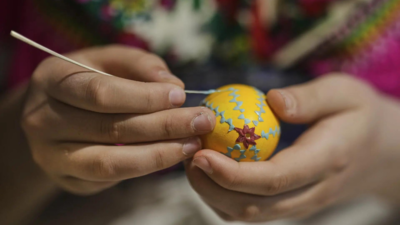Ciechanowiec's Museum of Easter Eggs: A Global Celebration of Folklore and Artistry

A historic manor house nestled in the charming Polish town of Ciechanowiec is home to an extraordinary and unique collection of Easter eggs sourced from around the globe. The Museum of Easter Eggs, an integral part of the Kluk Priest Krzysztof Agricultural Museum, recently reached a significant milestone, celebrating its 20th anniversary on April 3, 2024. Since its opening, it has become a prominent feature in the cultural landscape of Poland, attracting enthusiasts and tourists alike.
The museum boasts an impressive collection of Easter eggs from all seven continents, proudly showcasing the traditional Polish Easter eggs known as "pisanki," alongside various international versions. Visitors to the museum can immerse themselves in the rich history of this craft and gain insight into the diverse techniques employed by artisans representing different folkloric traditions worldwide.
Currently, the museum is home to an astounding 2,752 Easter eggs, with each piece carrying its own unique story and craftsmanship. Martyna Gieros, an expert from the ethnographic department of the museum, shared in an interview with Euronews, At the moment we have a collection of exactly 2,752 Easter eggs. We are proud of all of them, because there is a story behind each one, there is a person behind each Easter egg.
The origins of this remarkable collection can be traced back to the dedicated efforts of a married couple, Irena Stasiewicz-Jasiukowa and Jerzy Jasiuk. Irena, a respected professor at the Polish Academy of Sciences and the University of Warsaw, and Jerzy, who served as the long-time director of the Museum of Technology in Warsaw, devoted over three decades to collecting Easter eggs. Their passion for this art form was rooted not just in personal interest but also in their ties to CiechanowiecJerzy as a scientific council member and Irena through her scholarly research on Father Krzysztof Kluk, the museum's namesake.
After years of showcasing their collection through temporary exhibitions, the couple ultimately decided to donate around 1,000 pieces to the museum in Ciechanowiec. This generous act laid the foundation for the extensive collection seen today.
Among the treasures in the museums possession are not only the traditional Easter eggs crafted from chicken, duck, and goose eggs but also a variety of rarer egg types. The collection features eggs from peacocks, swans, storks, and even more exotic sources such as ostriches, penguins, and emus. One particularly noteworthy piece is a penguin egg that was brought back from Antarctica, making its presence in the museum all the more special. Additionally, the collection includes eggs fashioned from various materials, including wood and even semi-precious stones.
The decoration techniques on display at the museum are as diverse as the eggs themselves. Visitors can observe Easter eggs adorned through various methods such as the batik technique (using wax), engraving, and painting with oil, acrylic, or poster paints. One fascinating technique involves the openwork method, where intricate designs are cut directly into the eggshell.
In keeping with tradition, many of the decorated eggs incorporate natural elements as part of their designs. We have Easter eggs covered with natural grains, including poppy seeds, semolina, pasta, or apple seeds, Gieros explained, noting the creativity involved in using such materials. The collection also showcases eggs embellished with colorful yarn, cucumber seeds, rice, and buckwheat seeds.
The Museum of Easter Eggs features a vast array of exhibits from nearly every corner of the world. Alongside the beloved Polish "pisanki" from various regions including Podlasie, Kurpie, Kashubia, and Podhale, the collection also includes traditional Slavic eggs from Ukraine, Russia, and the Czech Republic. Furthermore, the geographical diversity extends far beyond Europe, featuring contributions from China, Japan, Kenya, Indonesia, Australia, and many other nations.
Tourists flock to the museum from both Poland and abroad, often bringing their own artistic creations. This influx of international contributions has enriched the museum's offerings, showcasing not just Polish Easter eggs but also pieces from almost every continent. Gieros emphasized this point, stating, The museum is already so well-known that many people have heard about it. Of course, we are not able to accept everything. We conduct a selection, choosing the most interesting pieces. Techniques of making are important to us, and above all we try to collect the traditional ones.
The cultural significance of decorated eggs extends far beyond their aesthetic appeal. While today, decorated eggs are primarily associated with Christian traditions and Easter celebrations, their history is steeped in ancient customs. Researchers from the University of Cambridge suggest that the practice of egg decoration has existed in southern Africa for over 60,000 years. The symbolism of eggs has long been intertwined with various cultural beliefs, often representing fertility and renewal. For instance, in ancient Mesopotamia, evidence of dyed eggs has been found, with customs spreading through the Mediterranean and eventually being embraced by various cultures, including the Persians. The tradition of painting eggs ultimately merged with Christian beliefs, symbolizing resurrection and the celebration of Easter.
In Slavic culture, the tradition of decorating eggs is often linked to the pagan holiday of Jare Gody, which marks the end of winter. During this festive time, Slavs would exchange dyed eggs as a ritual to ensure prosperity in the upcoming growing season. Furthermore, eggs were believed to possess life-giving energy, a belief that transcended cultural boundaries, with eggs sometimes being placed in the coffins of the deceased as tokens of new life.
Interestingly, in many Slavic communities, the art of decorating eggs, or kraszanki, was traditionally a feminine task. Young girls would prepare these eggs to present to boys as a form of "redemption," protecting themselves from being doused with water during Easter Monday festivities.
While the Easter Egg Museum in Ciechanowiec is a distinct and extraordinary establishment, it is not the only one of its kind globally. Similar museums exist in Ukraine, Russia, Hungary, Canada, and various other locations in Poland. However, Ciechanowiec's museum stands out for its comprehensive approach, documenting techniques and traditions from around the world, making it a true treasure for enthusiasts of folklore and tradition.
A visit to the Easter Egg Museum is more than just an exhibition; it represents a journey through time and across cultures. As visitors explore the remarkable, colorful array of Easter eggs, they come to appreciate the universal nature of this art form, which unites communities across the globe through the shared expression of creativity and tradition.

















